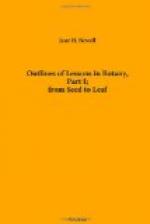[Footnote 1: See Physiological Botany. By Geo. L. Goodale. Ivison & Co., New York, 1885. Page 406.]
[Footnote 2: The following experiment exhibits the phenomenon of tension very strikingly. “From a long and thrifty young internode of grapevine cut a piece that shall measure exactly one hundred units, for instance, millimeters. From this section, which measures exactly one hundred millimeters, carefully separate the epidermal structures in strips, and place the strips at once under an inverted glass to prevent drying; next, separate the pith in a single unbroken piece wholly freed from the ligneous tissue. Finally, remeasure the isolated portions, and compare with the original measure of the internode. There will be found an appreciable shortening of the epidermal tissues and a marked increase in length of the pith.”—Physiological Botany, p. 391.]
The movements of the Sensitive Plant are always very interesting to pupils, and it is said not to be difficult to raise the plants in the schoolroom. The whole subject, indeed, is one of the most fascinating that can be found, and its literature is available, both for students and teachers. Darwin’s essay on “Climbing Plants,” and his later work on the “Power of Movement in Plants,” Dr. Gray’s “How Plants Behave,” and the chapter on “Movements” in the “Physiological Botany,” will offer a wide field for study and experiment.
3. Structure of Stems.—Let the pupils collect a series of branches of some common tree or shrub, from the youngest twig up to as large a branch as they can cut, and describe them. Poplar, Elm, Oak, Lilac, etc., will be found excellent for the purpose.
While discussing these descriptions, a brief explanation of plant-structure may be given. In treating this subject, the teacher must govern himself by the needs of his class, and the means at his command. Explanations requiring the use of a compound microscope do not enter necessarily into these lessons. The object aimed at is to teach the pupils about the things which they can see and handle for themselves. Looking at sections that others have prepared is like looking at pictures; and, while useful in opening their eyes and minds to the wonders hidden from our unassisted sight, fails to give the real benefit of scientific training. Plants are built up of cells. The delicate-walled spherical, or polygonal, cells which make up the bulk of an herbaceous stem, constitute cellular tissue (parenchyma). This was well seen in the stem of the cutting of Bean in which the roots had begun to form.[1] The strengthening fabric in almost all flowering plants is made up of woody bundles, or woody tissue.[2] The wood-cells are cells which are elongated and with thickened walls. There are many kinds of them. Those where the walls are very thick and the cavity within extremely small are fibres. A kind of cell, not strictly woody, is where many cells form long vessels by the breaking away of the connecting walls. These are ducts. These two kinds of cells are generally associated together in woody bundles, called therefore fibro-vascular bundles. We have already spoken of them as making the dots on the leaf-scars, and forming the strengthening fabric of the leaves.[3]




